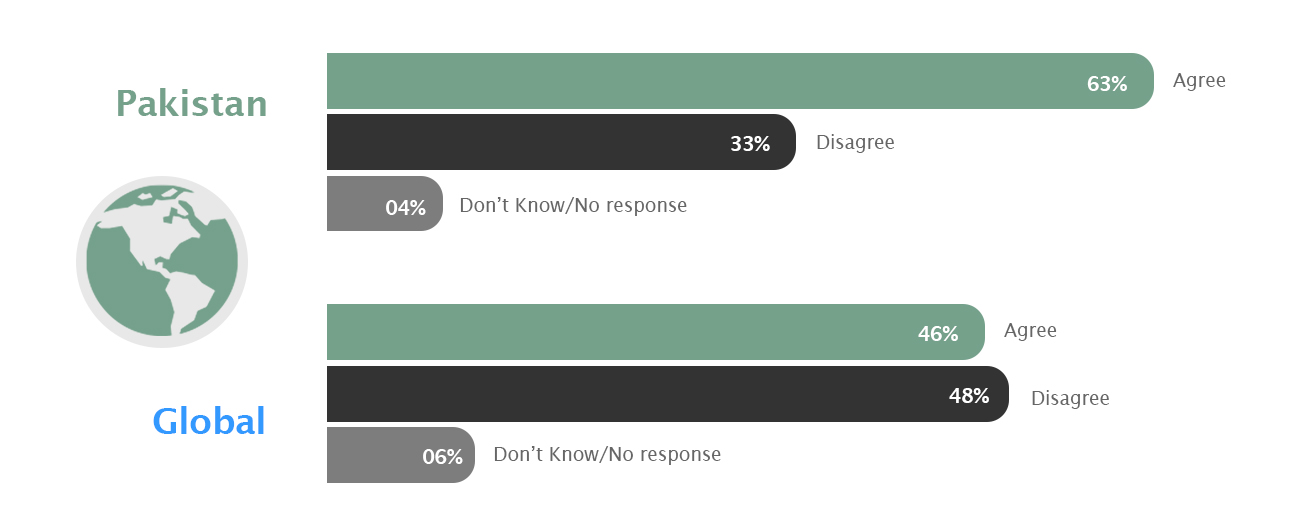Pakistanis & Climate
While much is discussed about Pakistan’s green economy initiative, the country’s citizens remain skeptical. In April 2020, Gallup conducted an opinion poll that showed 63% of Pakistanis believe it is too late to curtail climate change, versus a global average of 46% who believe the same.
To what extent do you agree or disagree that it is already too late to curtail climate change?

Source: Gallup & Gilani
While climate change is well underway – and Pakistanis have been feeling the effects, which likely contributes to the pessimism; the worst of climate change is not yet unavoidable. In the last article we spoke about what Pakistan has been doing over the past 5 years – mostly surprisingly good news, albeit with room for improvement. Now let’s look at what needs to happen moving forward.
Climate Inroads
Pakistan, especially over the last few years, has been highly involved in climate action conversations globally. The current Prime Minister takes every opportunity to highlight climate related realities, concerns and actions. As recently as November 2020, the PM spoke at the World Economic Forum, emphasizing climate change as the defining global challenge of the current generation. The PM goes on to cite reliable resources that quantify climate risks and talks about on the ground government activities to combat these as well. In December 2020, the PM again spoke at the Climate Ambition Summit 2020, highlighting the push to move to renewable energy sources, targeting 60% of national energy production via renewable sources by 2030.
If you, like me, are cynical of government statements vs action, you will be happily surprised to learn that the government has already mobilized capital working with the World Bank to begin working on this ambitious target. As part of this effort, the energy sector is being reformed and CPEC power projects being re-evaluated as well. Perhaps most importantly, there is firm commitment to stop new coal power development projects, with 2,600 MW additional development already canceled. If indigenous coal is used, it will be using ‘coal to liquid’ or ‘coal to gas’ methods, which are ‘greener’ methods of utilizing coal capacity explained in this article. These developments have also been lauded by the IEEFA. All this to say the country is on the right track in one of the most important sectors that will determine climate change outcomes.
Ambitions & Climate
Electric vehicles are a key industry in the fight to reduce emissions and while it has seen global growth over the past decade, the industry has barely received any attention in Pakistan. We spoke about this in the previous article as well. But again, there is promising news here as well, with the EV policy for 4 wheelers being approved in December 2020. Local startups are already showing promise in this field too, with Teleport, a Pakistani manufactured e-bike being launched late in 2020 as well. The target of 90% of all new vehicles being electric by 2040 is an ambitious one. However, it can help Pakistan significantly in moving toward a sustainable green economy.
Targets for % of new electric vehicle sales in Pakistan
According to the EV policy, electric vehicles will capture 90% of all new sales by 2040
Source: ICCT
The PM also re-emphasized nature-based measures the country is taking, including the tree plantation projects and increasing protected forest and national park lands. The current plan is to plant 10 billion trees in the next three years. Again, the government has already conducted a successful tree plantation project in one province, which lends credibility to them being able to replicate it on a national scale. Conservation and nature protection initiatives are being led under the “Protected Areas Initiative”.
Good news out of Pakistan is abundant – but this is a global issue needing global progress to enable effective change. On that front as well, there is positive news. Briefly, the COP26 summit coming up next year already has submissions from 76 countries detailing ambitious carbon reduction plans. Things are looking up.
The Labor Market & Climate
Moving into the new decade, coming off a year disrupted by a pandemic, with life still not back to normal presents a unique opportunity in terms of restarting in the right direction.
Pakistan has a big unemployment problem, with ‘Share of youth not in employment, education or training (NEET)’ at 31% in 2018. The pandemic disrupted the economy severely, meaning this number is likely much worse in 2020. Combine this with the fact that Pakistan has a ‘demographic dividend’, where 2-3 million people are expected to join the labor force every year for the next 40 years. Over 50% of the 220 million population is under the age of 24. Succeeding or failing at job creation and economic opportunity will be what determines the course the country takes.
Pakistan Population Pyramid 2020 (‘000)
Over 50% of Pakistan’s population is under the age of 24 making new job creation a priority
Source: World Population Review
In this respect as well, Pakistan has begun to take steps in the right direction, employing people laid off during the pandemic to plant trees. The thought behind this program is the sort of creative problem solving that when done at scale, will enable green jobs that reshape the economy into an environmentally sustainable one, while providing respectable livelihoods that enable improved standards of living to the burgeoning population. Restructuring toward a green economy has enormous job creation potential – and if done right, can also serve to improve wealth distribution and lift up the less well-off segment of the population. This is because job creation will be higher in more labor-intensive sectors – a notable example being establishing circular economies to reduce material extraction and waste generation versus disposable single use supply chains.
Job Creation & Climate
Let’s take a closer look at one of the most critical industries influencing climate change, to help us understand what effect re-structuring has in terms on employment. Focusing on the energy sector is important because it is arguably the most important sector that needs to be reformed to enable a green, sustainable future – and as discussed above, the government has indicated it is moving on this priority by limiting coal.
Reformation entails increasing renewables, reducing fossil fuel sources, and improving energy efficiency leading to reduced demand overall. This move toward a green economy will have multiplier effects up and down the value chain, including transportation (Electric vehicles) and construction (improving building energy efficiencies) – which in turn contributes to job creation and economic growth. According to the International Labour Organization, climate action to limit global warming to 2°C over the course of the century will result in net job creation of 0.3% globally over the business-as-usual scenario. This overall net job creation comes with a 41% reduction in greenhouse gas emissions by 2030.
Energy sustainability and employment in 2030 (% difference)
Climate action will result in net job creation across the energy value chain
Source: International Labour Organization
While the analysis estimates changes in employment globally, lessons can be extrapolated for Pakistan. Investment in the renewables sector (solar, hydro, wind, biomass) can lead to significant job creation, which will offset employment losses in the fossil fuels and utilities sectors. Due to economic linkages between sectors, employment in manufacturing, construction, services and waste management will also grow. Reformation of fossil fuel based sectors is inevitable. Getting ahead of the inevitable and taking control of the change can set Pakistan up to rebound from the COVID-19 catastrophe on the front foot. Climate change should really be seen as an economic opportunity for the country – well-structured economic incentives are very effective at encouraging sectoral growth. Combining this with the fact that ‘green’ jobs are very labor intensive means that Pakistan can solve two big problems, unemployment and climate change, by pushing a green economy.
The Individual & Climate
Although hope hinges on institutional and structural change as discussed above, individuals can contribute plenty. This website does a particularly good job of helping understand how individual habits can contribute to the problem and highlights key areas of improvement.
Taking myself as an example, potential obvious areas for improvement include the food I consume and the mobility options I choose.
Greenhouse gas emissions for food across supply chain (kgCO2eq/kg)
Methane production from cows and lamb means meat has a very high carbon footprint
Source: Poore and Nemecek (2018), Our World in Data
Food is particularly interesting, as it is not common knowledge how things we eat have an environmental impact. About half of the Earth’s biocapacity is caught up in producing food we eat. Meat products are significantly more resource intensive than plant counterparts – replacing a couple of weekly meat meals with vegetarian alternatives can have a sizeable impact over the long run. If we reduced global meat consumption by 50% and replaced these calories through a vegetarian diet it is equivalent to giving back 17 days’ worth of biocapacity to the planet.
I would encourage everyone to calculate their own footprints and learn the easiest ways you can be part of the solution, with similar detail for each aspect of our carbon footprints available. If we continue to work on sustainable practices toward a green economy, it is not too late to turn the tide on this problem. However, if we continue to believe and act like it is too late to curtail climate change; it will indeed be too late.




